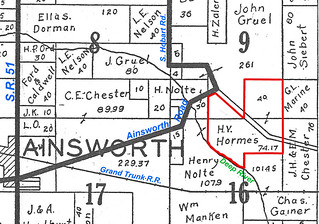
(Click on image to enlarge)
This image is from the 1926 Plat Book. Outlined in red is the Harms land as shown in the 1891 Plat Book. (Owing to the deficiencies of the 1926 map, I cannot be 100% certain that the dimensions of the Harms land were the same as in 1890.)
In the spring of 1902, Henry and Anna built themselves a nice house in the Joryville section of Hobart. It's not clear that they made it their permanent, full-time home until they retired there in 1915; they seem to have alternated between that house and their farm house. When they weren't living on their farm, they rented it, usually to a son or son-in-law.
Infant deaths aside (and I don't think I have yet encountered any family that did not suffer at least one such loss), they seem to have been fortunate people, or good at hiding their misfortunes. The impression one gets in reading the newspapers is that the Harmses were a happy, sociable, fun-loving bunch, extremely fond of throwing birthday parties, surprise or otherwise, for family members.
The Harms boys were apparently fond of driving, automotive or equine. We've heard John Harms in 1911 declaring his passionate love for automobiles. A year later, his two younger brothers, Henry Jr. and Herman, were driving a horse-drawn rig in Hobart when they were involved in a collision that the Gazette's report implied was their fault. "The Harms horse was being driven from town at a lively pace and boys were laughing and having a jolly time" when they crashed into a rig driven by William McAfee and carrying eleven people, including a baby. William had seen the Harms rig approaching fast and pulled over to the right, but could not avoid being struck. Fortunately no one was killed or permanently maimed. Henry suffered a broken shoulder blade, which probably taught him not to drive "without any regard to other's welfare in the road" (in the words of the Gazette).
As the Harms children reached adulthood and married, they had pretty ceremonies in the German Lutheran Church, followed by festive wedding dinners. In 1904, for example, when Mathilda Harms married Edward Niksch, she must have been a lovely sight — wearing a gown of cream-colored silk crêpe de chine and carrying a bouquet of white roses. Nearly a hundred guests attended the wedding dinner.
But on June 2, 1915, when Herman — the baby of the family — married the lively and fun-loving Minnie Rossow, the two large families came together for an epic blow-out that the Gazette called "without doubt the biggest wedding and celebration ever held in this vicinity." Nearly four hundred guests crammed into the church for the afternoon ceremony. Professor Albert Wolkenhauer, at the church organ, played the wedding march; at the end of the ceremony, the choral society to which both Herman and Minnie belonged sang; then the organ played the newlyweds out.
After the wedding party made a stop at August Haase's studio for a portrait, they and some 300 of their guests headed to the Rossows' place west of town, many of them riding the special streetcar had been chartered just for the purpose of ferrying guests between the church and the reception.
Out at the Rossow home, several large tents had been pitched in the yard to shelter the tables "that fairly groaned with the weight of the good things to eat." The open-air wedding dinner occupied the next couple of hours of that pleasant spring afternoon.
A dancing platform had been put up adjoining the house, and as the sun climbed down the sky, those who were not too stuffed to move began dancing, to the music provided by a four-piece Italian orchestra. The dancing went on for hours. Twilight came, then darkness, and starlight and candlelight. Around 10:00 p.m., the Hobart Commercial Club band arrived to give the orchestra a break. Still the celebration continued. Sometime in the wee hours of the morning, perhaps as the eastern sky was beginning to lighten, the happy crowd had at last had enough dancing and feasting, and the party broke up.
After the wedding, Henry and Anna Harms announced that their Joryville house was now their permanent home, and Herman and Minnie would henceforward live on and operate the family farm.
I was hoping to find somewhere in the description of that epic wedding some mention of the name Nolte. The young Harmses and the young Noltes were half-cousins, I guess you could say, Mary Harms Nolte having been Henry Harms' half-sister. They were also longtime neighbors, with only the Deep River separating the two family farms. Several cousins of the bride and groom were among the wedding party, but none was a Nolte. *sigh* I'd like to think the Nolte boys got out of the house for a night and partied like any young people whose family hadn't been decimated by tuberculosis.
Sources:
♦ 1870 Census.
♦ 1880 Census.
♦ 1890 Plat Book.
♦ 1900 Census.
♦ 1926 Plat Book.
♦ "Additional Local News." Hobart Gazette 5 June 1914.
♦ "Death of Mrs. Nolte." Hobart Gazette 17 July 1908.
♦ "General News Items." Hobart Gazette 7 Mar. 1902; 10 Feb. 1905; 22 Dec. 1905; 23 Mar. 1906; 25 Jan. 1907; 5 June 1908.
♦ "Harms-Rossow Wedding." Hobart Gazette 4 June 1915.
♦ "Harms-Rossow." Hobart News 3 June 1915.
♦ "Henry Harms Surprised on His Sixty-First Birthday." Hobart News 25 Dec. 1913.
♦ Indiana Marriage Collection.
♦ "Local Drifts." Hobart Gazette 24 Apr. 1903; 22 May 1903; 20 Nov. 1903; 10 June 1910; 22 Dec. 1911.


No comments:
Post a Comment